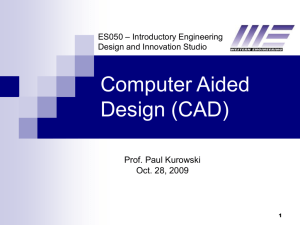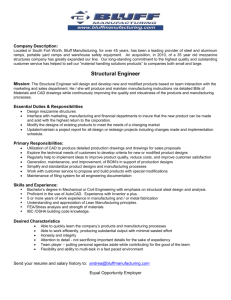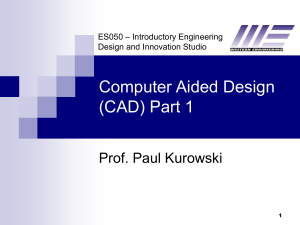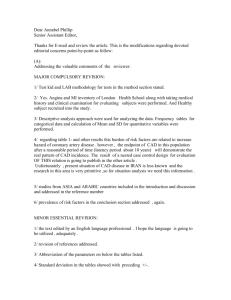Team-based design and CAD modelling using Lego in first year
advertisement
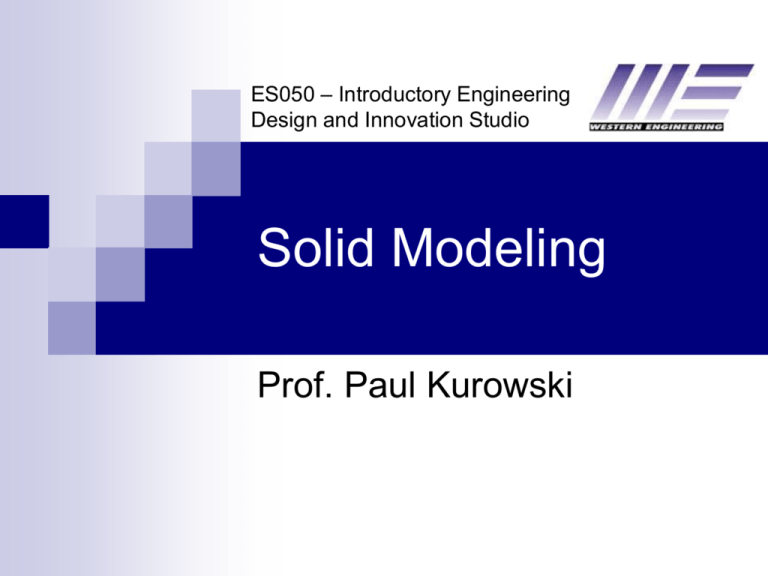
ES050 – Introductory Engineering Design and Innovation Studio Solid Modeling Prof. Paul Kurowski Evolution of CAD Technology Solid model Surface model Wire frame model Drawing Evolution of CAD Tools 1970’s Manual drafting Electronic drafting board 1980’s Wire frame geometry Surface geometry 1990’s Solid geometry MODERN CAE TOOLS COMPUTATIONAL FLUID DYNAMICS FINITE ELEMENT ANALYSIS CAD SOLID, PARAMETRIC, FEATURE BASED ….. MOTION ANALYSIS ….. CAD (Computer Aided Design) is at the hub of other CAE (Computer Aided Engineering) tools IN ES1050 WE USE SolidWorks CAD SOFTWARE You can burn your installation CDs in SEB1005 Installation instructions are here: http://www.eng.uwo.ca/designcentre/CAD%20resources/default.htm DESIGN CENTRE WEB SITE DESIGN CENTRE WEB SITE - CAD RESOURCES CAD RESOURCES – SolidWorks TUTORIALS Manual Drawings 2D representations used to represent 3D objects multi-view drawings pictorials Standards and conventions developed so that 3D object could be built from drawings Drawings created manually or using 2D CAD Difficult to visualize, errorprone, time-consuming 2D CAD Simply replaces manual drawing Provides a set of drawing tools to create 2D elements Lines, circles, arcs, etc. More accurate, easier changes to drawings Still no 3D representation of the object Example: AutoCAD 3D Wire frame Modeling Geometric entities are lines and curves in 3D Volume or surfaces of object not defined Easy to store and display Hard to interpret ambiguous What is this? Problems with wire frame models 3D Surface Modeling Models 2D surfaces in 3D space All points on surface are defined useful for machining, visualization, etc. Surfaces have no thickness, objects have no volume or solid properties Surfaces may be open A Surface Model created using Alias StudioTools Surface Model created using Rhino Solid, parametric, feature based modeling Complete and unambiguous SOLID - models have volume, and mass properties Feature based - geometry built up by adding and subtracting features Parametric - geometry can be modified by changing dimensions Parametric, Feature-based Solid Model PARAMETER SOLID GEOMETRY BASE FEATURE (“POSITIVE” SOLID) CHILD OF BASE FEATURE (“NEGATIVE” SOLID) panel 01.SLDPRT Solid, parametric, feature-based Modeling Software High-end (more powerful) NX (UGS) Catia (Dassault Systémes) Pro/Engineer (Parametric Technologies Corp.) Mid-Range (easier to use) Solid Edge (UGS) Inventor (Autodesk) SolidWorks (SolidWorks Corp.) They all work basically the same way Feature-Based Solid Modeling Parts modeled by adding features to a base part Features represent “operations” holes, ribs, fillets, chamfers, slots, pockets, etc. Material can be added or subtracted Features can be created by extrusion, sweeping, revolving, etc. Feature-based Modeling Process Create base part Add features until final shape is achieved Extruded Base Extruded Cut ES1050 part 01.SLDPRT Extruded Cut Feature History Trees Most feature-based modelers show the features and their order in a graphical tree view This view has different names, depending on the software Solid Edge Feature Pathfinder Pro/E Wildfire Model Tree SolidWorks Feature Manager Design Tree Modifying Parts The part is created from the history tree Features can be added, deleted and reordered Feature parameters can be changed ES1050 part 01.SLDPRT ES1050 part 01.SLDPRT ES1050 part 01.SLDPRT ES1050 part 01.SLDPRT Summary Most CAD systems use solid, parametric, feature-based modeling Parts are modeled by adding features to a base feature Features can be easily added, deleted and modified
